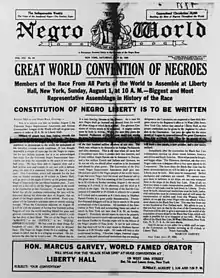Negro World
Negro World was the newspaper of the Marcus Garvey's Universal Negro Improvement Association and African Communities League (UNIA). Founded by Garvey and Amy Ashwood Garvey, the newspaper was published weekly in Harlem, and distributed internationally to the UNIA's chapters in more than forty countries.[1] Distributed weekly, at its peak, the Negro World reached a circulation of 200,000.[2]

Notable editors included Marcus Garvey, T. Thomas Fortune,[3] William H. Ferris,[4] W.A. Domingo and Amy Jacques Garvey.[5]
Background
Garvey founded the UNIA in July 1914, and within the organization's first few years had started publishing Negro World.[6]
Monthly, Negro World distributed more copies than The Messenger, The Crisis and Opportunity (other important African-American publications). Colonial rulers banned its sales and even possession in their territories, including both British Empire and French colonial empire possessions.[6][7] Distribution in foreign countries was conducted through black seamen who would smuggle the paper into such areas.
Negro World ceased publication in 1933.
Content
For a nickel, readers received a front-page editorial by Garvey, along with poetry and articles of international interest to people of African ancestry. Under the editorship of Amy Jacques Garvey the paper featured a full page called "Our Women and What They Think".
Negro World also played an important part in the Harlem Renaissance of the 1920s. The paper was a focal point for publication on the arts and African-American culture, including poetry,[8] commentary on theatre and music, and regular book reviews. Romeo Lionel Dougherty, a prominent figure of the Jazz Age, began writing for Negro World in 1922.[9]
Contributors
Notable editors and contributors to Negro World included:
- Duse Mohamed Ali
- John Edward Bruce
- Wilfred Adolphus Domingo
- William Henry Ferris
- Timothy Thomas Fortune
- Amy Ashwood Garvey
- Amy Jacques Garvey
- Hubert Henry Harrison
- Samuel Alfred Haynes[10]
- Zora Neale Hurston
- John G. Jackson
- Robert Lincoln Poston
- Andy Razaf
- Joel Augustus Rogers
- Arthur Schomburg
- William Alexander Stephenson
- Eric Walrond
- Carter Godwin Woodson
References
- Blain, Keisha N. (2018). Set the World on Fire: Black Nationalist Women and the Global Struggle for Freedom. University of Pennsylvania Press. ISBN 978-0-8122-4988-0.
- West, Sandra (2003). "Negro World". In Aberjhani (ed.). Encyclopedia of the Harlem Renaissance. Infobase Publishing. ISBN 978-1-4381-3017-0.
- Finkelman, Paul, ed. (2009). "Negro World". Encyclopedia of African American History. Oxford University Press, USA. ISBN 978-0-19-516779-5.
- Wintz, Cary D.; Finkelman, Paul (2004). Encyclopedia of the Harlem Renaissance: K-Y. Taylor & Francis. ISBN 978-1-57958-458-0.
- Taylor, Ula Yvette (October 16, 2003). The Veiled Garvey: The Life and Times of Amy Jacques Garvey. Univ of North Carolina Press. ISBN 978-0-8078-6229-2.
- Tony Martin (1976). Race First: The Ideological and Organizational Struggles of Marcus Garvey and the Universal Negro Improvement Association. The Majority Press. pp. 10–14. ISBN 978-0-912469-23-2. Retrieved April 30, 2013.
- Marcus Garvey (1995). Marcus Garvey and Universal Negro Improvement Association Papers: June 1921 – December 1922. Africa for the Africans. University of California Press. p. xlviii. ISBN 978-0-520-20211-5. Retrieved April 30, 2013.
- Encyclopedia of the Harlem Renaissance. Vol. 1: A – J. Taylor & Francis. January 1, 2004. p. 33. ISBN 978-1-57958-457-3. Retrieved April 30, 2013.
- Tony Martin, Literary Garveyism: Garvey, Black Arts and the Harlem Renaissance, 1983.
- Winston James (1998). Holding Aloft the Banner of Ethiopia: Caribbean Radicalism in Early Twentieth-century America. Verso. p. 67. ISBN 978-1-85984-140-2. Retrieved April 30, 2013.